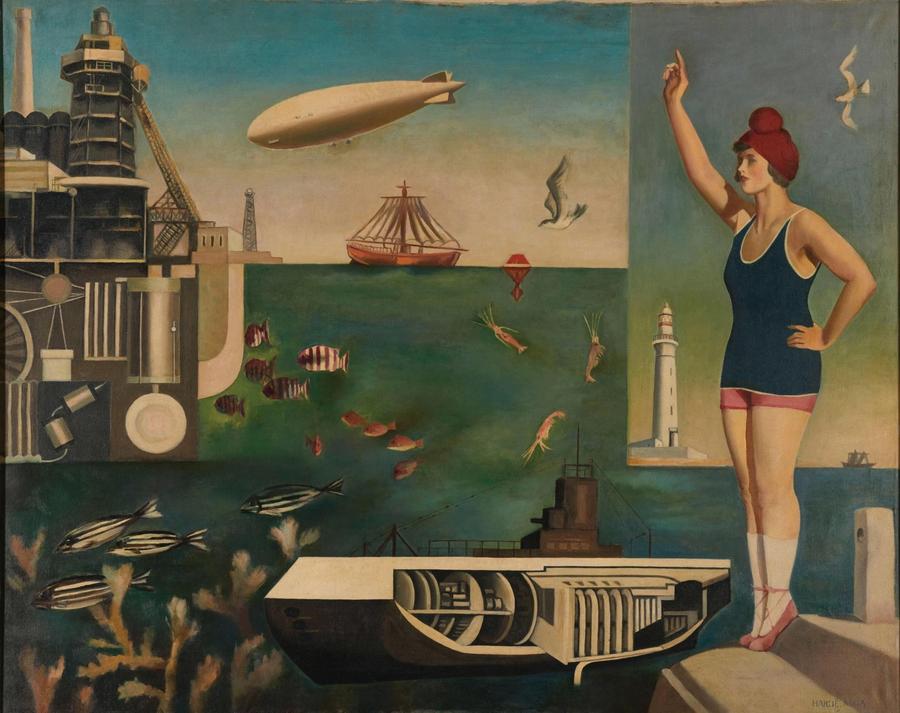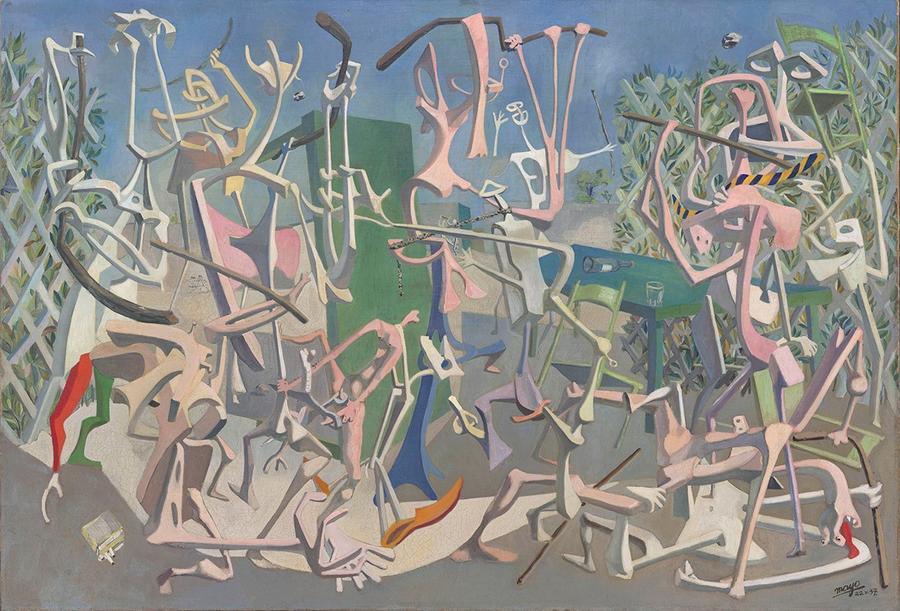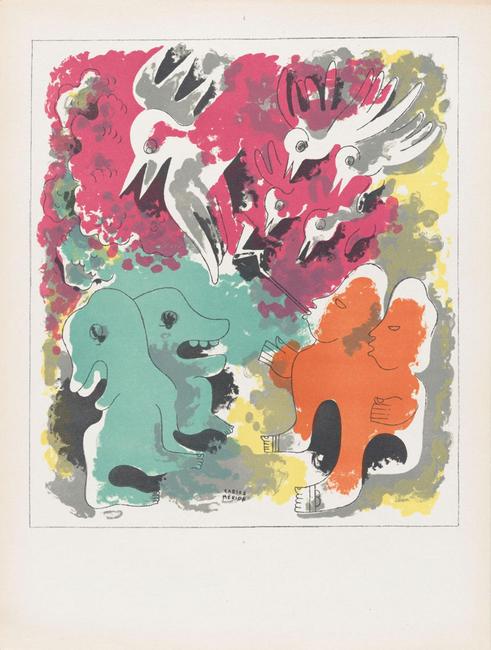The Metropolitan Museum of Art
October 11, 2021, through January 30, 2022
Tate Modern, London
February 24-August 29, 2022.

Nearly from its inception, Surrealism has had an international scope, but understanding of the movement has come primarily through a Western European orientation. The major exhibition Surrealism Beyond Borders reconsiders the true “movement” of Surrealism beyond boundaries of geography and chronology—presenting it as networks that span Eastern Europe to the Caribbean, Asia to North Africa, and Australia to Latin America. With examples from almost eight decades, produced across 45 or more countries, the exhibition offers a fresh appraisal of some of the collective concerns and exchanges—as well as historical, national, and local distinctions—that will recast appreciation of this most revolutionary and globe-spanning movement. Surrealism Beyond Borders is on view at The Metropolitan Museum of Art from October 11, 2021, through January 30, 2022, and then travel to the Tate Modern, London, February 24-August 29, 2022.

Max Hollein, Marina Kellen French Director of The Met, said, “Surrealism is an ‘ism’ of the art world that really went global—and its universal and complex artistic language has had a lasting effect on creative imagination and production. Even those who are familiar with Surrealism will find this show to be full of surprises and discoveries. Surrealism is often presented as a canonical, monolithic movement, but in this important exhibition we see it as something more dynamic and connected, something that has enabled artists to imagine the world beyond their own artistic, cultural, social, or political situation—and continues to do so today. This groundbreaking show not only opens up the field of Surrealist studies but generates broader questions about modernism itself.”

Sheena Wagstaff, Leonard A. Lauder Chairman of The Met’s Department of Modern and Contemporary Art, added, “A radical idea that infiltrated culture in many global cities, Surrealism demonstrates how important deep research by scholars living within all regions of the world can circulate and gain currency. Rather than taking a universalist approach, this ambitious show offers a nuanced and expansive telling of the history of this art, which aligns with the core mission of the modern and contemporary art program at The Met. By reappraising old orthodoxies, this exhibition speaks to local terrains and their specific cultural, historical, and geopolitical conditions, while following the flow of crosscurrents of influence across the world.”
Exhibition curator Stephanie D’Alessandro, Leonard A. Lauder Curator of Modern Art and Senior Research Coordinator in Modern and Contemporary Art at The Met, added, “Surrealism is inherently dynamic and has traveled and evolved from place to place and time to time. Its scope is (and always has been) international and, more specifically, transnational—extending across national borders to unite ideas and people, while also remaining specific and local in its liberatory drive. The works in the exhibition represent just a sample of the ways artists around the world have continued to take up Surrealism since its inception in the 1920s.”
A revolutionary idea sparked in Paris around 1924, Surrealism prioritized the unconscious and dreams over the familiar and everyday. While Surrealism has often generated poetic and even humorous works—such as Salvador Dalí’s telephone receiver that morphs into a lobster, or Renè Magritte’s miniature train that rushes from a fireplace—it has also been deployed by artists around the world as a serious weapon in the struggle for political, social, and personal freedom. The dynamic, transhistoric, and transnational paths presented in the exhibition acknowledge not only the shared and special interests of artists associated with Surrealism but also the conditions under which they lived and worked. The presentation includes paintings, sculpture, works on paper, photography, films, and radio plays, as well as examples of rare publications that animate the vibrancy of Surrealism. Organized into 14 galleries, the exhibition explores the collective interests shared by artists across regions and presents a selection of the points around the world where Surrealism’s convergence, relay, and exchange shine through. The exhibition also considers some of the events and conditions of the last hundred years that have impinged on Surrealism, including the pursuit of independence from colonialism and the experience of exile and displacement wrought by international conflict. Neither singular in narrative nor linear in chronology, the exhibition pushes beyond traditional borders and conventional narratives to draw a map of the world at the time of the Surrealists as an interrelated network—one that makes visible many lives, locations, and encounters linked through the freedom and possibility offered by Surrealism.
Eight galleries will reconsider familiar themes related to Surrealism and its exploration of the unconscious to overcome habit and convention—such as “The Uncanny” and “The Body of Desire”—but from a fresh, wide geographic and temporal perspective. In the gallery devoted to “The Work of Dreams,” for example, the familiar and iconic Two Children Frightened by a Nightingale (1924), by Max Ernst, will be seen alongside a less familiar work by Antonio Berni, Landru in the Hotel, Paris (1932), a painting that appeared in the first exhibition of Surrealism in Argentina. Visitors will also find Skunder Boghossian’s Night Flight of Dread and Delight (1964), painted by the artist following his experience of the work by Wifredo Lam and Roberto Matta, which offered him a way of merging his experience of the Black diaspora with Surrealism.
The gallery “Bodies of Desire” focuses on the connection between the unconscious and the subject of love and erotic obsession. Familiar examples are the photographs of Hans Bellmer that manifest the complicated desires of heterosexual men and their gaze on the female body. In contrast to such well-known works, visitors will see Ithell Colquhoun’s Scylla (1938)—a clever double image by a member of the London Surrealist group—that embodies a shifting imagery of the erotic that invokes and involves a woman’s body along with her palpably felt urges and sensations. They will also experience the photographs of Lionel Wendt, who learned of Surrealism while living in Ceylon (present-day Sri Lanka); his photographs project onto bodies of color an erotic of queer desire. For Wendt, Surrealism offered the possibility to mediate more personal concerns, particularly his own sexual desires, legible in his homoerotic photographs of nude working-class men posed like classical sculpture. These works, exhibited in London in 1938 and Colombo in 1940, represent something rare for the time: the image of same-sex desire outside a Western context. They are complicated by Wendt’s position of power and privilege as a member of the Burgher community in Ceylon.
In addition to revising and expanding on familiar themes, Surrealism Beyond Borders also considers a number of places where artists have converged and, through coming together, relayed and exchanged ideas of Surrealism. Five focused galleries will highlight the variety of experiences of Surrealism in Paris, at the Bureau of Surrealist Research; in Cairo, with the al-Fann wa-l-Hurrīya/Art et Liberté (Art and Liberty) group; in Haiti, Martinique, and Cuba, as multiple waves initiated by writers; in Mexico City, shaped by the creative bonds of women artists; and in Chicago, where it was deployed as a tool of radical politics. Along with these focused sections, special loans from a multitude of locations—including the photographs of Limb Eung-Sik and Jung Hae Chang from Korea and a film by Dušan Marek from Australia—will offer insight into the adoption and adaption of Surrealism around the world.
Concentrated considerations of the political and social conditions that have had an effect on artists and their connection to Surrealism over many years will be threaded through the galleries. “Thoughts in Transmission,” “Travel, Exile, and Displacement,” “The Fantasy and Fallacy of Elsewhere,” and “Under Pressure” will chart a multitude of conditions in which artists found and engaged with Surrealism. Topics include the effects of 20th-century technology and social advancements; geopolitics; and colonialism, racism, and persecution. “Under Pressure” includes examples of how those who associated themselves with Surrealism negotiated potential surveillance and the threat of repression. The little-known photographs of Cecilia Porras and Enrique Grau, who produced images that defied the conservative social conventions of 1950s Colombia, are presented here. That these images have long remained in a private album with limited public exposure until their presentation at The Met testifies to the potential controversy provoked by their transgressive, choreographed narratives. Other related presentations include the exile of Eugenio Granell and the origin of El Mirador Azul (The Blue Lookout), the first group dedicated to Surrealism in Puerto Rico.
The exhibition also includes a special presentation of the 36-foot drawing Long Distance (1976–2005) by Ted Joans and 132 contributors from around the world. Joans’s very identity was shaped by travel and dislocation: to travel was to discard what he regarded as the constraints of nationality, language, and culture—boundaries that could impose artificial, and sometimes violent, limits on freedom, including the racism he experienced in the United States. His adage “Jazz is my religion, Surrealism is my point of view” reflects the free-form and itinerant lifestyle he adopted in his movement through North and Central America, North and West Africa, and Europe. Travel not only allowed freedom; it also provided community, as witnessed in his many collaborative works, including Long Distance, a cadavre exquis (exquisite corpse) drawing that the artist began in 1976. It would accompany Joans to London, Lagos, Dakar, Marrakesh, New York, Rome, Berlin, Mexico City, Toronto, and beyond, growing with invited contributions. With a production span of nearly 30 years (two beyond Joans’s own life), Long Distance extends the Surrealist idea of collaborative authorship to include far-flung people the artist united through his travels.
Artists associated with Surrealism have relied on exhibitions and journals to exchange ideas, extend networks across national boundaries, and unite diasporic communities (people of common origin or belief dispersed geographically). To animate some of these routes of communication, the exhibition will include many rare journals and manifestos—from Yifeng (Art Wind, Shanghai, 1935) to A partir de cero (Starting from Zero, Buenos Aires, 1952–56), and from Tropiques (Fort-de-France, 1941-44) to Surrealist Insurrection (Chicago, 1968–72). Film and radio—though each demanded financial and technological resources not available to all artists—also brought new adherents to Surrealism, and the presentation’s special selection of radio broadcasts and films will further bring Surrealism to life.